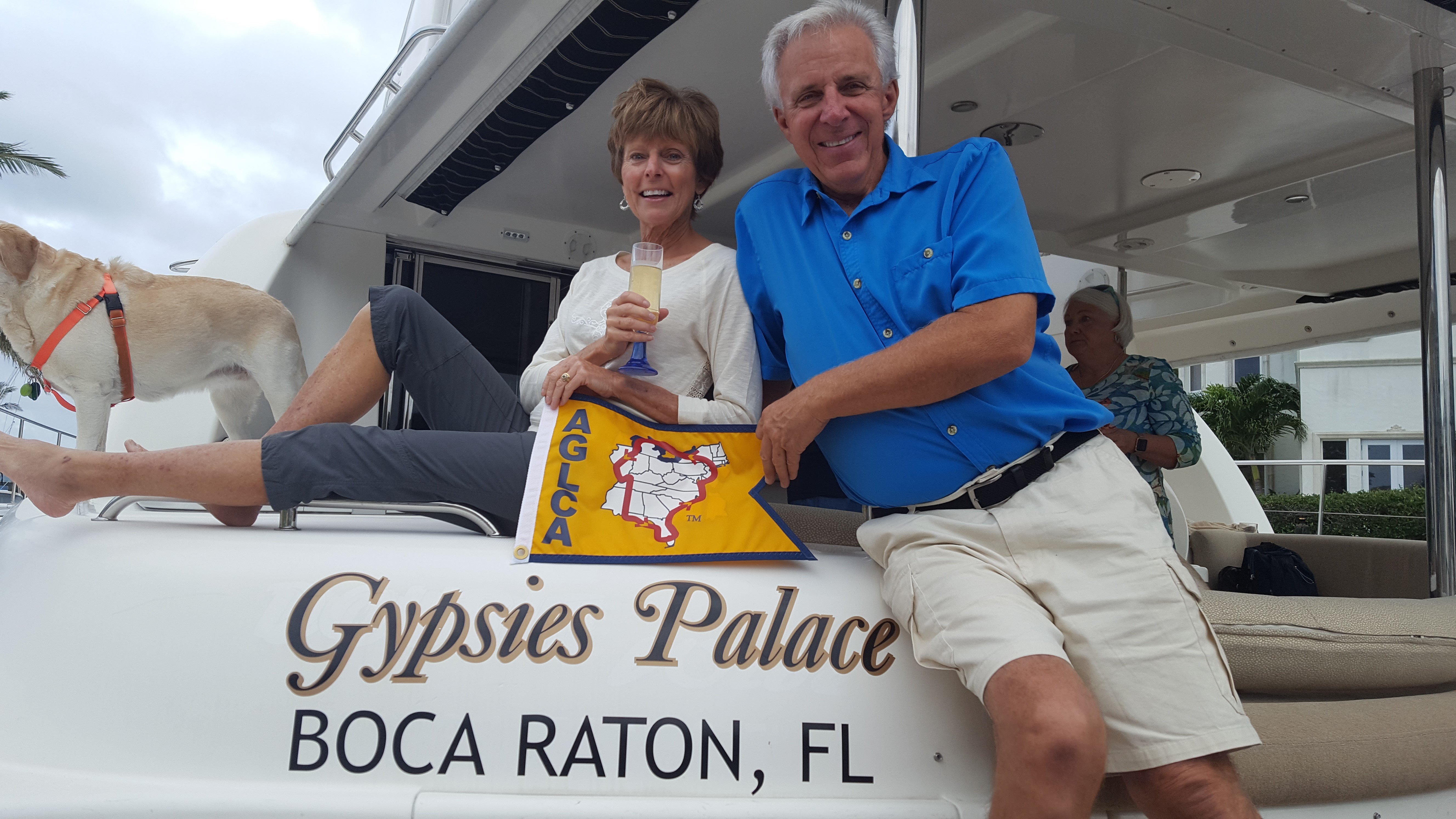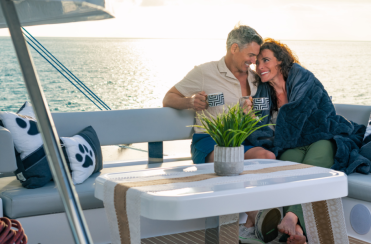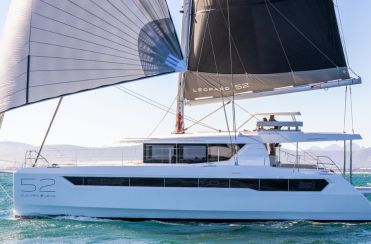
If you’ve never heard of the Great Loop, you’re not alone. When Steve and Debbie Russell bought Gypsies Palace, their Leopard Powercat 47, they hadn’t either. The couple planned to cruise full-time but had no particular itinerary besides seeing the Bahamas. When Debbie spotted an advertisement for the Great Loop in a magazine, the idea captivated her. Within a few months, they’d made a plan and started America’s Great Loop.
“I think we were the first Leopard to do the Great Loop in 2017,” Debbie told us. “Most people were thinking about trawlers and cabin cruisers, and there wasn’t a lot of information on whether you could even take a powercat through all the locks and bridges.”
But they did, and it was the experience of a lifetime.
The Great Loop Route
The Great Loop is a circumnavigation of the Eastern United States via coastal and inland waterways of the U.S. and Canada. It runs up the east coast from Florida to New York, along the Hudson River to the Great Lakes, then back down inland rivers to the Mississippi River and the Gulf of Mexico, closing the loop back in Florida. Yes, that’s one long trip. It can cover between 5,200 and 6,000 miles depending on how you go. So, it’s no surprise that most people spend a year traveling the loop.
The route includes the Gulf of Mexico, the Atlantic Ocean, the Great Lakes, the Intracoastal Waterway, many rivers, including major ones like the Mississippi, Illinois, and Ohio, and the eastern canal system. You’ll pass through at least fifteen U.S. and Canadian states along the way, but the exact number will vary with your route.
Planning Your Route on the Great Loop
There are many ways to complete the Great Loop. You can make route choices along the way, based on what you want to see and any limitations on your boat. You can start anywhere along the loop. There’s no official “starting line” and the loop is complete whenever you re-cross the place where it all started.
Boaters typically make the Great Loop in a counterclockwise direction and time their departure so they will spend the summer months in the north and fall and winter in the southern climates. Not everyone does the loop in a single pass. Some store the boat along the way and come back, returning the next season to press on.
Moving north on the East Coast from Florida and south back from Chicago provides favorable currents in most inland rivers. You can make the Great Loop in the other direction, but that means reckoning with the Mighty Mississippi’s powerful current.
Social Cruising – Meeting Other Loopers
The Great Loop can be a very social experience, and most “Loopers” identify themselves with a burgee from the AGLCA – America’s Great Loop Cruising Association. Since almost everyone travels in the same direction and stays in anchorages and marinas along the way, it’s easy to find each other, make friends and cruise in company.
“Docktails” are frequent get-togethers after a day on the water. Loopers meet at one or more boats on the docks, bringing drinks and appetizers to share while discussing the day’s travels and tomorrow’s plans. Steve and Debbie made more than 500 Looper friends, some of whom they’re still in touch with years later. Of course, you’re not obligated to join the groups, but you’ll never lack company if you want it.
What Makes a Good Boat for the Great Loop?
There are many suitable boats for a Great Loop, but there are a few absolute limits that rule out some. The loop route goes through locks, under a lot of bridges, and through shallow waters. Alternate routes exist for many of the tightest points, but there are some you must clear.
Three key factors limit the size of boats on the Great Loop – draft below the water, air draft, and beam. There’s no hard limit on length, but some of the tight turns are a challenge beyond seventy feet. There is one stretch along the upper Mississippi that does not have a fuel stop for 200 miles, though without this range, it can be solved with extra fuel cans and bladders.
Both the Leopard 40 Powercat, and the Leopard 46 Powercat have the beam, draft, and air draft to make it around the loop.
The lowest bridge and absolute limit for air draft on the Illinois River is 19.7′. Many boats remove antennas, radar units, and tall equipment. But if you can’t get your boat below 19.6′, you won’t be able to pass the bridge. There are lower bridges in places like the Erie Canal and the Chicago River downtown, but there are alternate routes to get around them.
The Trent-Severn waterway in Canada has a lock with a 22′ beam limit. This runs from Lake Ontario to Lake Huron, but there is an alternate route through Lake Erie that wider boats can take. While there is much discussion about finding dockage for beamy boats like Powercats, the Russells never had a problem finding space for their Leopard 47 PC.
Some parts of the Great Loop transit canals and inland rivers have shifting shallows. The recommended maximum draft is five feet.
Living Along the Way – Choosing a Boat with the Best Accommodations
The other side of fitting through the canals and bridges is living on the boat. For a 6,000-mile trip, you’ll be spending the better part of a year on the boat. And when living on board full-time or just for months at a stretch, comfort and space are at a premium.
Full-sized beds, a workable galley for preparing full meals, and cockpit and saloon space for entertaining all enhance your Great Loop experience. You can certainly make the loop in a smaller boat, and many have done so. But there’s no reason not to be comfortable if it’s within your reach.
Leopard Powercats are Perfect for the Great Loop
After spending a year on the Great Loop on a Leopard Powercat, Steve and Debbie Russell wouldn’t do it any other way. For them, the power catamaran experience was ideal. And being out there with a lot of different boats, from trawlers to cabin cruisers, they saw nothing which compared favorably.
You simply won’t find a more comfortable and suitable boat that meets the Great Loop’s size restrictions. The combination of well-designed space, construction quality, and livable comfort is second to none.
Plenty of Space
The living space on a Leopard powercat is large, open, and bright. The spacious saloon, aft entertainment area, and sun lounge on the flying bridge provide plenty of room for relaxing and entertaining. A full-sized galley with ample counter space and an upright refrigerator gives you all the comforts of living on shore. The owner’s and guest cabins below offer plenty of privacy and comfort with full-sized beds and en suite heads.
Over time, Steve and Debbie noticed that Docktails were happening more often around their boat. With space for a crowd, they became a natural host boat. They even took a group of twenty-five out for a sunset cruise one evening and came back with more than a couple of Powercat converts.
Leopard Powercats also have loads of storage, with some in each cabin, under floorboards, and around the saloon. The Russells turned a crew cabin into Steve’s “man cave” and a dedicated workshop for his tools, and brought more along with them than they found they needed.
Performance and Fuel Economy
The wider catamaran platform with two hulls provides a smooth, stable ride that monohulls cannot offer. In conditions that cause monohulls to rock and roll, the catamaran hulls provide a flat ride with no rolling motion. This means comfort when the wind is up and conditions are less than ideal.
The narrow hulls and dual engines make for an efficient ride. Sleeker hull forms make for better fuel economy from low-speed traveling in tight canals to high-speed crossings over broad bodies of water.
Over large stretches of water, powercat speed shines. “Crossing the Gulf of Mexico, the trawler people do an overnight crossing,” Debbie says, “We just cut across the Gulf on a nice day, easily making 175 miles in daylight.”
Setting up a Leoprd 40 PC for the Great Loop
The Leopard 40 PC and the Leopard 46 PC are both under 18’6″ in vertical clearance. This doesn’t include antennas, so it’s close but manageable. For a new Powercat or a refit, choose installations that make it easier to get under those low bridges. Folding antenna and radar mounts can make your bridge-clearing conversion a snap. Otherwise, learn how to prep your boat to get under the limit by removing protruding antennas.
Watch that vertical clearance, make sure you have good ground tackle, and you are good to go.
America’s Great Loopers Cruisers Association
The AGLCA is a great source of detailed loop information. The group offers reasonably priced membership, and joining does not require owning a boat or committing to do the loop. They’ve got everything from cost calculators and equipment guides to forums and communities for meetups and webinars. If you’re considering the Great Loop, it’s worth a membership to get a sense of the undertaking.
Many Loopers have blogs and social media accounts loaded with details and facts. And if you find a Looper, it’s easy to get them talking about it. It’s an experience of a lifetime, and all of them are happy to share.
Just look for that AGLCA pennant.







